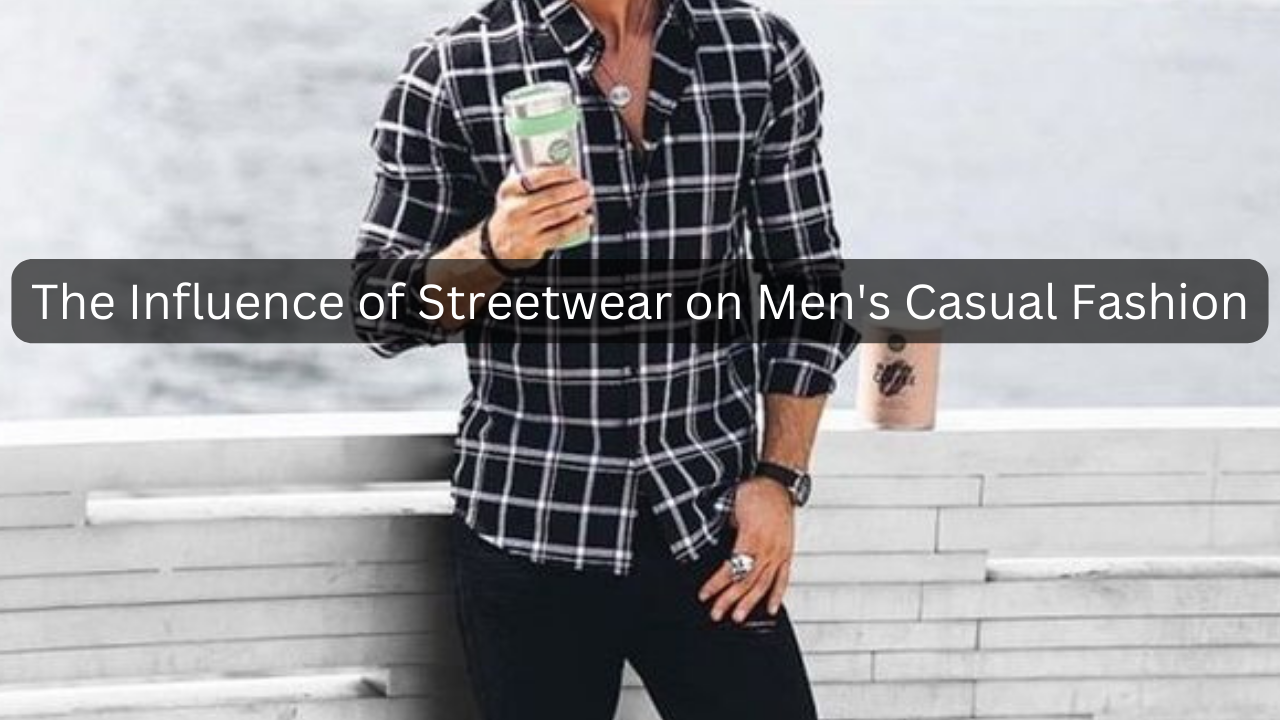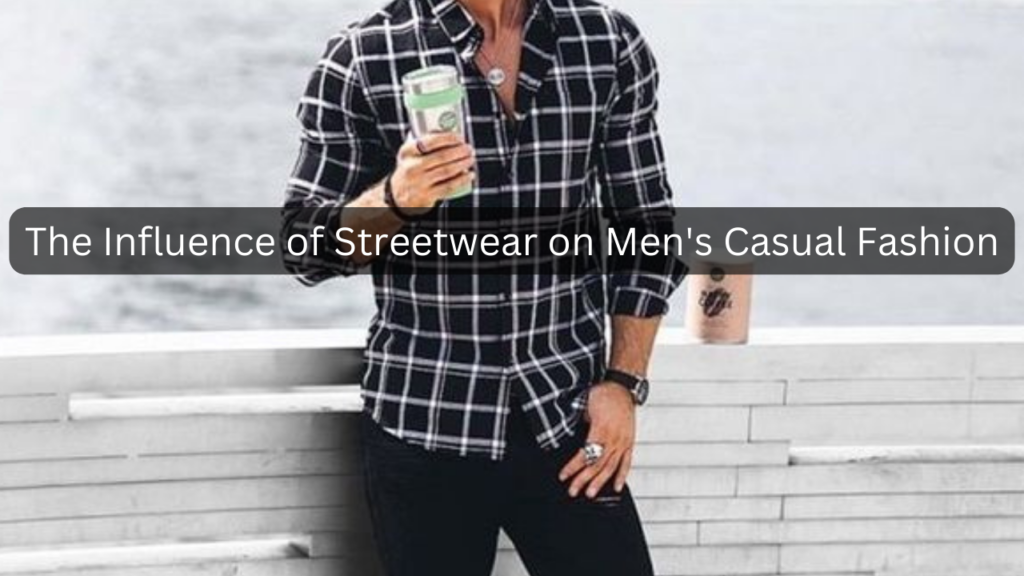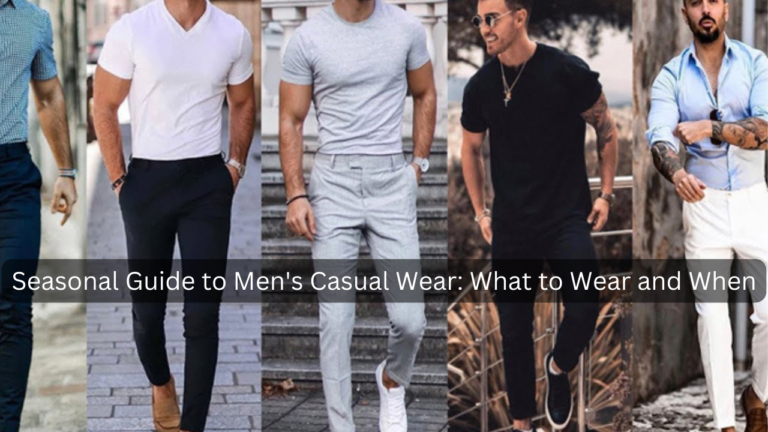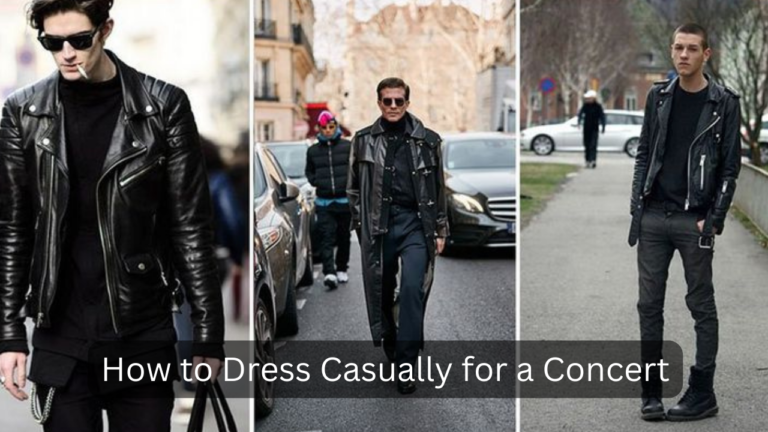

Table of Contents
Introduction
In the dynamic realm of men’s fashion, few movements have been as transformative and pervasive as streetwear. Originating from the gritty landscapes of urban America, streetwear has transcended its humble beginnings to become a global phenomenon influencing how men dress casually today. This style movement, characterized by its fusion of high fashion, youth culture, and urban aesthetics, has not only redefined casual attire but has also left an indelible mark on the fashion industry as a whole.
Definition of Streetwear in the Context of Men’s Fashion
Streetwear, within the context of men’s fashion, bodies a distinctive blend of casual and edgy elements rooted in urban subcultures. It embraces a range of garments such as graphic t-shirts, hoodies, sneakers, and oversized outerwear, often characterized by bold logos and designs. Beyond its sartorial aspects, streetwear represents a lifestyle and attitude—youthful, rebellious, and deeply connected to music, art, and street culture. This multifaceted approach has made streetwear not just a fashion choice but a statement of identity and cultural belonging for many.
Brief History and Evolution of Streetwear as a Style Movement
The evolution of streetwear traces back to the 1970s and 1980s, emerging from the skateboard and surf scenes of California and the hip-hop culture of New York City. Influenced by brands like Stussy, Supreme, and later, A Bathing Ape (BAPE), streetwear initially catered to niche urban communities seeking comfortable yet stylish clothing that reflected their distinct cultural affiliations. Over the decades, streetwear has expanded globally, crossing cultural boundaries and evolving with influences from high fashion, sportswear, and avant-garde aesthetics.
This evolution has been marked by collaborations between streetwear brands and luxury fashion houses, the rise of streetwear-inspired collections in runway shows, and the democratization of fashion through social media and online platforms. Today, streetwear continues to push boundaries, inspiring new trends and challenging traditional notions of casual outfit attire in men‘s fashion.
Key Elements of Streetwear
Streetwear is characterized by several key elements that define its distinct aesthetic and cultural significance within men’s fashion:
Origins in Urban Culture and Youth Movements
Streetwear emerged from the streets of urban centers, where youth cultures sought clothing that reflected their lifestyles and attitudes. Initially rooted in skateboarding, surf culture, and the rebellious spirit of inner-city neighborhoods, streetwear offered a departure from mainstream fashion by embracing a more relaxed and authentic style.
Characteristic Features: Graphic Tees, Hoodies, Sneakers, etc.
At the core of streetwear are its signature garments:
Graphic Tees: Often featuring bold logos, slogans, or artistic designs that convey a message or reflect cultural references.
Hoodies: Comfortable and versatile, hoodies became synonymous with streetwear for their practicality and ability to showcase graphics or branding prominently.
Sneakers: Footwear plays a crucial role in streetwear, with brands like Nike, Adidas, and Vans becoming iconic for their sneaker designs that blend performance with street style.
Oversized Silhouettes: A departure from traditional fitted clothing, streetwear often embraces oversized shapes and proportions for a relaxed and effortless look stylish.
Influence of Hip-Hop, Skateboarding, and Other Subcultures
Streetwear’s evolution is deeply intertwined with various subcultures:
Hip-Hop Culture: Artists and musicians played a pivotal role in popularizing streetwear, with rappers like Run-D.M.C. and Tupac Shakur incorporating brands like Adidas and Timberland into their iconic looks.
Skateboarding: Brands such as Vans and Thrasher magazine not only catered to skaters’ needs but also shaped streetwear’s aesthetic with durable, functional designs.
Graffiti and Art: Streetwear often draws inspiration from urban art forms, including graffiti and street murals, which influence graphic designs and patterns on clothing.
This fusion of urban culture, youth movements, and artistic expressions continues to drive the evolution of streetwear, making it a dynamic force in contemporary men’s fashion.
Impact on Men’s Casual Fashion
Transition from Niche to Mainstream: How Streetwear Became Popular
Streetwear’s journey from niche urban cultures to mainstream fashion has been marked by its ability to resonate with a broader audience seeking authenticity and individuality in their attire. What started as a subcultural movement in the streets of cities like New York and Los Angeles gradually gained momentum through grassroots promotion and word-of-mouth among trendsetting youth. The internet and social media played crucial roles in amplifying streetwear’s appeal, allowing enthusiasts to connect and share their styles globally.
Rise of Streetwear Brands and Collaborations with High Fashion
Streetwear’s ascent to mainstream prominence was accelerated by collaborations between streetwear labels and high fashion houses. Brands like Supreme, Off-White, and Palace gained cult status through limited-edition drops and collaborations with luxury names such as Louis Vuitton and Balenciaga. These partnerships not only bridged the gap between streetwear and haute couture but also legitimized streetwear’s influence on the global fashion landscape.
Adoption by Celebrities and Influencers: Driving Trends
Celebrities and influencers have played a pivotal role in popularizing streetwear, often showcasing the latest drops and collaborations on social media platforms. Hip-hop artists, athletes, and actors embraced streetwear brands as staples of their off-duty wardrobes, influencing millions of followers to emulate their style. This celebrity endorsement not only fueled demand for streetwear but also propelled trends such as athleisure and oversized fits into the mainstream.
The impact of streetwear on men’s casual fashion goes beyond clothing—it represents a cultural shift towards comfort, dress self-expression, and the blurring of boundaries between high and low fashion. As streetwear continues to evolve and innovate, its influence on casual look attire remains a driving force in shaping contemporary men’s fashion trends worldwide.
Streetwear Essentials in the Casual Wardrobe
Core Pieces: Hoodies, Joggers, Bomber Jackets, etc.
Streetwear essentials are characterized by their comfort, versatility, and distinct style tips elements:
Hoodies: Essential for layering or as standalone outerwear, hoodies offer warm and style with their casual wear vibe and often feature graphic prints or logos.
Joggers: Comfortable and functional, joggers combine streetwear aesthetics with athletic influences, featuring elastic cuffs and sometimes bold patterns or details.
Bomber Jackets: A streetwear staple known for its versatility and classic silhouette, bomber jackets add an edgy yet timeless appeal to casual wear outfits.
Integrating Streetwear into Everyday Outfits
Incorporating streetwear into everyday outfit wear involves blending casual pieces with personal style:
Layering: Use hoodies or bomber jackets over basic tees or shirts for a relaxed yet put-together look taller.
Footwear: Shoes are key to streetwear; pair them with jeans or joggers for a casual yet stylish ideas ensemble.
Accessories: Caps, backpacks, and statement socks can further enhance a streetwear-inspired outfit.
Mixing Streetwear with Classic Menswear: Tips for a Balanced Look
Achieving a balanced look good between streetwear and classic menswear involves thoughtful pairing:
Contrast Textures: Combine streetwear pieces like hoodies or bombers with tailored trousers or a blazer for a sophisticated contrast.
Focus on Fit: Ensure streetwear items fit well to maintain a polished appearance.
Subtle Accents: Incorporate streetwear through accessories or a single statement piece, keeping the overall outfit cohesive.
By strategically mixing streetwear essentials with classic menswear staples, individuals can create outfits that reflect both personal style and current fashion trends, making streetwear a versatile and integral part of the modern casual wardrobe.
Cultural and Social Influence
Representation and Diversity in Streetwear Culture
Streetwear culture is deeply rooted in diversity and representation, reflecting a range of identities and backgrounds:
Inclusive Aesthetics: Streetwear embraces diverse styles and influences, drawing inspiration from various cultural expressions such as art, music, and local subcultures.
Celebrating Subcultures: Brands and designers often collaborate with artists and communities to celebrate and amplify voices that may have been historically marginalized.
Expression of Identity Through Clothing Choices
Clothing within streetwear serves as a powerful medium for self-expression and identity:
Personalization: Individuals customize their outfits with unique combinations of brands, colors, and accessories to reflect their personalities and affiliations.
Empowerment: Streetwear empowers wearers to defy conventional fashion norms, fostering a sense of individuality and confidence.
Influence on Global Fashion Trends and Consumer Behavior
Streetwear’s impact extends beyond clothing preferences to shaping broader fashion trends and consumer behavior:
Cultural Fusion: Globalization has enabled streetwear to transcend geographical boundaries, influencing fashion trends worldwide.
Shift in Consumer Preferences: Millennials and Gen Z consumers prioritize authenticity, comfort, and social consciousness, aligning with streetwear’s values and aesthetic.
The cultural and social influence of streetwear underscores its role as more than just a fashion trend—it is a cultural movement that celebrates diversity, empowers individual expression, and shapes the collective consciousness of contemporary fashion on a global scale.
Sustainability and Ethical Considerations
Challenges of Mass Production and Environmental Impact
The rise of streetwear has brought to light significant challenges associated with mass production and its environmental consequences:
Fast Fashion Model: Rapid production cycles and cheap materials contribute to waste and environmental degradation.
Resource Consumption: High water usage, chemical pollution, and textile waste are common issues in the fashion industry.
Rise of Sustainable Streetwear Brands and Initiatives
In response to these challenges, sustainable streetwear brands are emerging with a commitment to ethical practices and environmental stewardship:
Materials: Using organic cotton, recycled fibers, and innovative fabrics like Tencel or hemp to reduce environmental impact.
Production Practices: Emphasizing fair labor practices, local manufacturing, and reducing carbon footprints throughout the supply chain.
Circular Economy: Promoting garment longevity through repair, resale, and recycling programs to minimize waste.
Consumer Awareness and Changing Preferences
Consumer awareness about sustainability issues is driving a shift in preferences towards more eco-friendly and ethical fashion choices:
Educated Choices: Informed consumers seek transparency from brands regarding sourcing, manufacturing, and ethical practices.
Demand for Accountability: Social media and digital platforms amplify consumer voices, holding brands accountable for their environmental and social impact.
Preference for Quality: There’s a growing preference for quality over quantity, favoring durable, timeless pieces over trend-driven fast fashion.
As sustainability continues to shape the future of Streetwear on Men’s Casual Fashion, sustainable streetwear brands and initiatives play a crucial role in fostering a more responsible and ethical industry. By prioritizing environmental stewardship and ethical practices, these brands not only contribute to reducing fashion’s ecological footprint but also inspire a cultural shift towards conscious consumerism.
Future Trends and Innovations
Evolution of Streetwear: Where is it Headed Next?
Streetwear’s evolution continues to be shaped by shifting cultural dynamics and technological advancements:
Inclusivity and Diversity: Embracing diverse cultural influences and expanding representation across gender, race, and identity.
High Fashion Integration: Further blurring the lines between streetwear and high fashion through continued collaborations and elevated designs.
Global Influence: Increasing globalization leads to the fusion of regional styles and the adoption of streetwear trends worldwide.
Impact of Technology on Streetwear Design and Production
Technology is revolutionizing streetwear in design, production, and consumer engagement:
Digital Fashion: Virtual and augmented reality enhance the shopping experience, allowing consumers to visualize garments before purchase.
Sustainable Innovations: Advancements in sustainable materials and manufacturing processes reduce environmental impact without compromising style.
Customization and Personalization: AI and 3D printing enable personalized streetwear, catering to individual preferences and sizes.
Emerging Trends in Materials, Styles, and Consumer Expectations
Future streetwear trends are characterized by innovation, sustainability, and consumer-centric approaches:
Materials: From biodegradable textiles to lab-grown fabrics, sustainable materials redefine streetwear’s environmental footprint.
Styles: Hybrid styles that blend formal and casual elements, along with adaptive clothing that responds to varying climates and activities.
Consumer Expectations: Increased demand for transparency, ethical sourcing, and customization options drives brands to innovate and adapt.
As streetwear continues to evolve, its future lies in embracing technological advancements, sustainability initiatives, and cultural inclusivity. By staying ahead of trends and consumer expectations, streetwear remains a dynamic force in shaping contemporary fashion landscapes globally.
Conclusion
Throughout its journey from urban subcultures to global fashion prominence, streetwear has fundamentally reshaped Streetwear on Men’s Casual Fashion leaving an enduring mark on style and culture.
Summary of Streetwear’s Influence on Men’s Casual Fashion
Streetwear revolutionized men’s casual fashion by introducing a blend of comfort, self-expression, and cultural resonance. From its humble origins in skateboarding and hip-hop to its integration into mainstream couture, streetwear redefined casual attire with its distinctive aesthetic and inclusive appeal.
Reflection on its Lasting Impact and Cultural Significance
The lasting impact of streetwear extends beyond clothing—it embodies a cultural movement that celebrates diversity, empowers individuality, and challenges traditional fashion norms. By embracing streetwear, individuals not only express their identities but also contribute to a global dialogue on style, authenticity, and social consciousness.
Personal Takeaways for Embracing Streetwear in Individual Style
Embracing streetwear in personal style offers opportunities for creativity, authenticity, and sustainability. By incorporating streetwear essentials and embracing its values of inclusivity and innovation, individuals can cultivate a wardrobe that reflects their personality while contributing to a more conscious fashion industry.
In conclusion, streetwear’s journey illustrates its evolution from a niche subculture to a driving force in contemporary fashion. Its influence on men’s casual fashion underscores its ability to adapt, inspire, and resonate across generations, making streetwear not just a trend but a cultural phenomenon with enduring relevance in the modern world.





